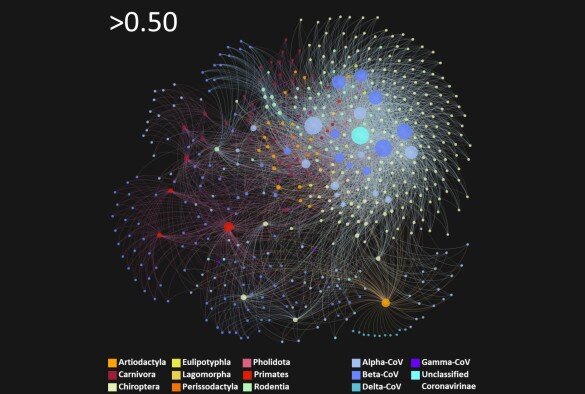The potential scale of novel coronavirus generation in wild and domesticated animals may have been highly underappreciated, suggests new University of Liverpool research.
Published in Nature Communications, the machine-learning study identifies mammals that are potential sources for generating new coronaviruses, including species implicated in previous outbreaks (such as horseshoe bats, palm civets and pangolins) and some novel candidates.
Predicting which animals could potentially be the source of a future coronavirus outbreak may guide approaches to reduce the risk of coronavirus emergence in animals and spill-over to human populations.
“New coronaviruses can emerge when two different strains co-infect an animal, causing the viral genetic material to recombine. Our understanding of how susceptible different mammals are to different coronaviruses has been limited, but such information could offer insights into where viral recombination might occur,” explained co-lead researcher Dr. Maya Wardeh from the Institute of Infection, Veterinary and Ecological Sciences.
The researchers sought to bridge this knowledge gap by using a machine-learning approach to predict relationships between 411 strains of coronavirus and 876 potential mammalian host species. They predict the mammals that are most likely to be co-infected, and therefore be potential recombination hosts for the production of novel coronaviruses.
Find your dream job in the space industry. Check our Space Job Board »
Their findings suggest that there are at least 11 times more associations between mammalian species and coronavirus strains than have been observed to date. In addition, they estimate that there are over 40 times more mammal species that can be infected with a diverse set of coronavirus strains than was previously known.
“Given that coronaviruses frequently undergo recombination when they co-infect a host, and that SARS-CoV-2 is highly infectious to humans, the most immediate threat to public health is recombination of other coronaviruses with SARS-CoV-2,” said Dr. Marcus Blagrove, co-lead of the study.
The researchers went on to identify hosts in which SARS-CoV-2 recombination could potentially occur and indicate there may be 30 times more host species than currently known. Notable new predicted hosts include the dormitory camel, African green monkey and the lesser Asiatic yellow bat.
Highlighting, as a specific example, the high-risk scenario of recombination occurring between the highly transmissible SARS-CoV-2 and the more deadly MERS-CoV, the researchers also identify 102 potential recombination hosts of the two viruses and recommend monitoring for this event.
The researchers note that their results draw on limited data on coronavirus genomes and virus-host associations, and that there are study biases for certain animal species, all of which present uncertainty in the predictions. However, recent testing of potential mammalian hosts for their susceptibility to SARS-CoV-2 has already confirmed a number of their predictions, such as the raccoon dog, the domestic goat and the alpaca.
“It is important to note that viral recombination is distinct from mutations. Recombination occurs over longer periods of time and can generate completely new strains or species. Our work can help target surveillance programs to discover future strains before they spill-over to humans, giving us a head-start in combating them,” concluded Dr. Blagrove.
The researchers now plan to expand their model to include bird species, therefore, encompassing the full range of important coronavirus hosts, and a species-level contact network, accounting for behavior and habitat utilization of host species, to give a broader overview of potential coronavirus associations.
Provided by: University of Liverpool
More information: Maya Wardeh et al. Predicting mammalian hosts in which novel coronaviruses can be generated. Nature Communications (2021) DOI: 10.1038/s41467-021-21034-5
Credit: University of Liverpool











